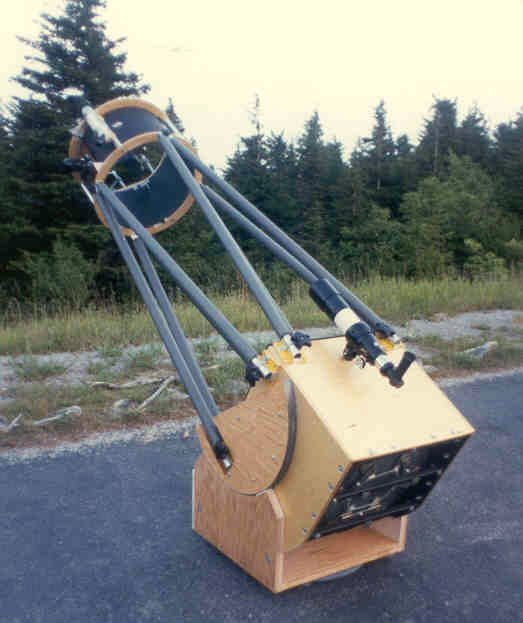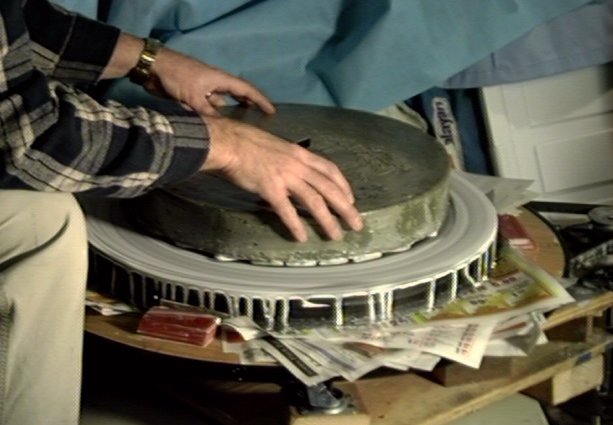Leanne- my 20 inch f5 Scope
This is the result of a long Winter's bout with aperture fever in the Ohio Cloud Belt

At 9 feet tall, and 150 pounds, Leanne takes less space in the car than the fiberglass-tube 12.5" f5 she replaced.
Here she's set up on Spruce Knob, highest point in West Virginia, for first-dark.
First-light was at the Astronomy Club of Akron in June, 1999
(photo and scan by Dave Miller)
Second-light was near Mohican State Park in Ohio.
Notice the temporary C-Clamps for balance until I raised the mirror cell.
I had to get a new 8 foot stepladder.
The open mirror cell lets the mirror cool rapidly.
It's Krylon ultra-flat-black spray paint inside the mirror box.
The design is based on Kriege and Berry's book, "Building Large Dobsonian Telescopes".
The cabinetry is 5/8 Baltic Birch with doubled 3/4" Oak plywood for the base and altitude trunnions. Several coats of Minwax polyurethane varnish completed the job. In the 3 years since this book was published, some breakthroughs in lightweight construction have started to spread, and I can see where 20 pounds or so could be removed from this design without affecting function. Maybe next time.
Looking away, you see the welded heavy-wall steel tubing and the 18 point stainless steel cell.
The green tubing has since been replaced by a ring of perforated aluminum to align the 6 stainless steel triangles. I also recently added a 12V fan.
Grinding the mirror

I ground, polished, and figured the mirror in my basement in the winter of 1998/99.
This 24", 3 rpm turntable is powered by a gearmotor from a large Xerox machine that I took apart. A truck fanbelt drives the plywood pulley under the cleat deck. It's supported on casters, with a pipe flange and pin central pivot. Here you see the concrete grout and ceramic tile grinding tool, being used with 500 grit.
Grinding the BVC blank took a month, polishing took a month, and figuring took 6 weeks. My wrists couldn't handle the torque of polishing, so I polished and figured by hand, giving the turntable a spin, rotating the blank and changing papers frequently to randomize it. It worked; there is no apparent astigmatism
The Foucault tester uses a dial indicator.
A magnet behind the brass stage holds the razor blade in position. The stainless rod, lamp housing, and some other parts came from the Xerox machine.
A foucogram at about 70% shadow
This was taken about 30 figuring steps from completion. You can still see some remnants of the pitch lap square interval on the surface. Alas, the scratch you see at lower right is still with us. This is a Snappy capture from a camcorder on a tripod, zoomed on the knife edge.
This is the view with the Couder mask at zone 3.
According to my log, it took 178 figuring steps, but the first 100 don't count, because I had to learn when and how to use a sub-diameter lap. I used 14, 10, 6, 4, 2, and 1/2 inch pitch laps to figure the thing. Before this, I'd ground a pair of 8" f6 mirrors, and this really wasn't much different except for the duration of the task and the need to master sub-diameter laps.
The BVC mirror on the test stand
The test stand folds back and rolls on casters to transport the mirror from measurement to figuring stations. Black Vitrified Ceramic gives a brilliant image in your Foucault tester, and doesn't change shape much as it cools after handling. I was able to make repeatable measurements after only about 15 minutes on the stand until the last dozen or so little touches, when I took no chances.
Using a 20" scope
The View
I'd had a 35mm Panoptic eyepiece for a couple of years, when I had the 12.5" f5 scope, but usually just used a 32mm Plossl to avoid the hassle of changing from 1 1/4 to 2" eyepieces. My favorite view was with a 26 or 17mm Plossl.
With the big scope, though, the impact of a low power 2" eyepiece is dramatic. At 100" focal length, most Messier objects are framed nicely with the 35mm, which would correspond to a 22mm on the 12.5 . Bright Messiers like the Orion and Omega Nebulas, and the Whirlpool galaxy just about knock you off the ladder.
Star Parties
I've brought Leanne to a half dozen star parties, and she's a real crowd-pleaser. So far she's been at least as big as anything else on the field, so lots of people have wanted to take a look. One "Omigod" is worth a million bucks; it makes it all worthwhile.
On from here
I kept the Bartels drive parts from my 12.5" scope when I sold it, so this winter's project is to adapt the computerized drive to this much larger load. I've already had Andy Sauleitis machine a new altitude roller and shaft to match the 26" diameter trunnion, and I have one of Mel's new optically-isolated boards to stuff.





